You might not realize that neglecting basic maintenance on your Ducati can lead to costly repairs down the line. Regular oil changes, tire pressure checks, and chain maintenance are just a few of the essential practices you should follow to keep your motorcycle in top shape. However, there are some lesser-known tips that can make a significant difference in performance and longevity. Understanding these can enhance your riding experience and guarantee your bike performs at its best for years to come. What are these key maintenance tips that every Ducati owner should know?
Key Takeaways
- Change the oil and filter every 3,000 to 5,000 miles to ensure optimal engine performance and longevity.
- Regularly check and maintain tire pressure, ideally before each ride, for safety and better handling.
- Inspect the brake system before every ride, ensuring fluid levels and pads are in good condition.
- Clean and lubricate the chain every 300-600 miles, checking for tension and signs of wear regularly.
Regular Oil Changes
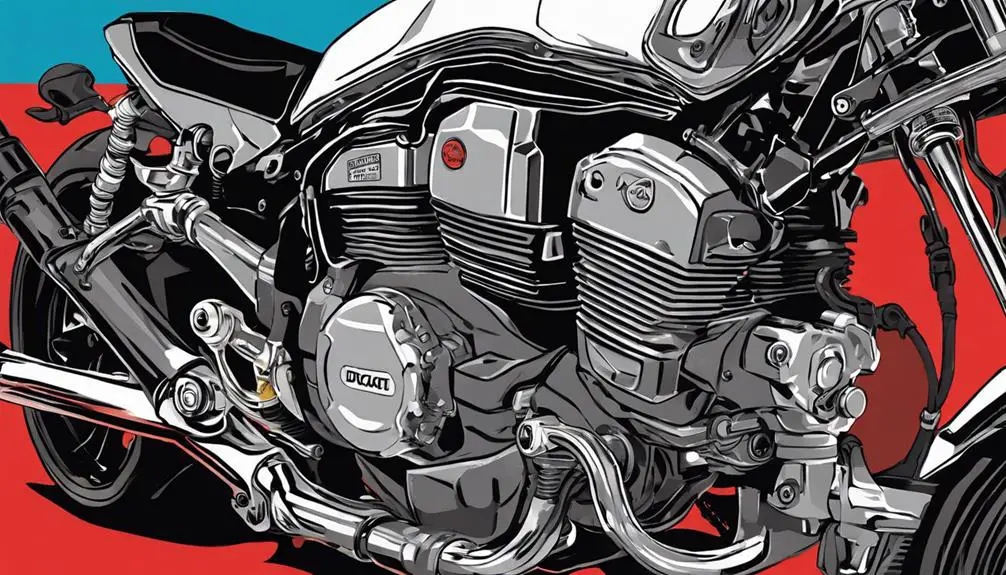
To keep your Ducati running smoothly, you should regularly change the oil and filter to secure peak performance and longevity. Fresh oil not only lubricates the engine but also prevents dirt buildup that can hinder its power. You'll experience that delicious roar of freedom when your bike's engine operates at its best, and that feeling is worth the effort.
Start by checking your owner's manual for the recommended oil change interval. While many suggest every 3,000 to 5,000 miles, your riding style and environment can dictate more frequent changes. If you ride hard or in harsh conditions, don't hesitate to change your oil sooner.
When you change the oil, always replace the filter as well. A clean filter guarantees that the oil flowing through your engine remains free of contaminants, allowing it to function efficiently. Use high-quality oil that meets Ducati's specifications, as this will maximize your bike's performance and lifespan.
Embrace the ritual of oil changes; it's not just maintenance, it's a commitment to your freedom on the open road. Taking care of your Ducati means you're investing in countless exhilarating rides ahead.
Tire Pressure Checks
Keeping your tire pressure at the right level is essential for your Ducati's performance and safety.
You should check it regularly, especially with changing weather conditions that can affect pressure.
Let's explore how proper maintenance can enhance your riding experience.
Importance of Proper Pressure
Maintaining the correct tire pressure is essential for ensuring your Ducati's performance, safety, and longevity on the road. Under-inflated tires can lead to poor handling, decreased fuel efficiency, and increased tire wear, while over-inflated tires can compromise your grip and make your ride less stable. You want your bike to respond beautifully to your commands, and proper tire pressure is key to achieving that.
When you ride with the right pressure, you're not just enhancing your experience; you're also boosting your safety. Correctly inflated tires provide better traction, which can be vital when maneuvering sharp turns or wet surfaces. Plus, it means fewer trips to the repair shop, allowing you to spend more time enjoying the open road.
It's also worth noting that proper tire pressure helps maintain the overall balance and alignment of your Ducati, allowing for a smoother, more liberated ride. So, take a moment before you hit the road to check those tires.
Feeling the freedom of the ride is exhilarating, and you deserve to experience it at its best. Your Ducati's performance hinges on those tires, so keep them in check!
Checking Frequency Guidelines
Regularly checking your tire pressure—ideally before each ride—ensures peak performance and safety on your Ducati. Keeping your tires inflated to the manufacturer's recommended PSI not only enhances handling but also contributes to fuel efficiency. You wouldn't want to compromise your exhilarating ride or risk safety due to under or over-inflated tires.
Make it a habit to check your tire pressure when the tires are cold, as heat from riding can cause pressure to rise. This simple act takes just a few minutes but can greatly affect your bike's performance. If you're planning an extended journey, consider checking your tire pressure at least once every couple of weeks to maintain ideal conditions.
Don't forget to inspect the tread and sidewalls for any signs of wear or damage while you're at it. Embracing this proactive approach liberates you from potential mishaps on the road, allowing you to truly enjoy the freedom your Ducati offers.
Adjusting for Weather Changes
As weather conditions change, adjusting your tire pressure becomes essential to guarantee peak performance and safety on your Ducati.
When temperatures drop, tire pressure decreases, which can lead to decreased grip and stability. Conversely, in warmer weather, tire pressure can rise, increasing the risk of blowouts.
To keep your ride exhilarating, check your tire pressure regularly, especially before long journeys. Use a reliable gauge and always follow the manufacturer's recommended pressure specifications. It's a simple task that makes a world of difference in handling and comfort.
When you feel the air turning crisp or the sun blazing down, take a moment to tweak your tires. This small act empowers you, ensuring you maintain control over your journey.
Brake System Inspection
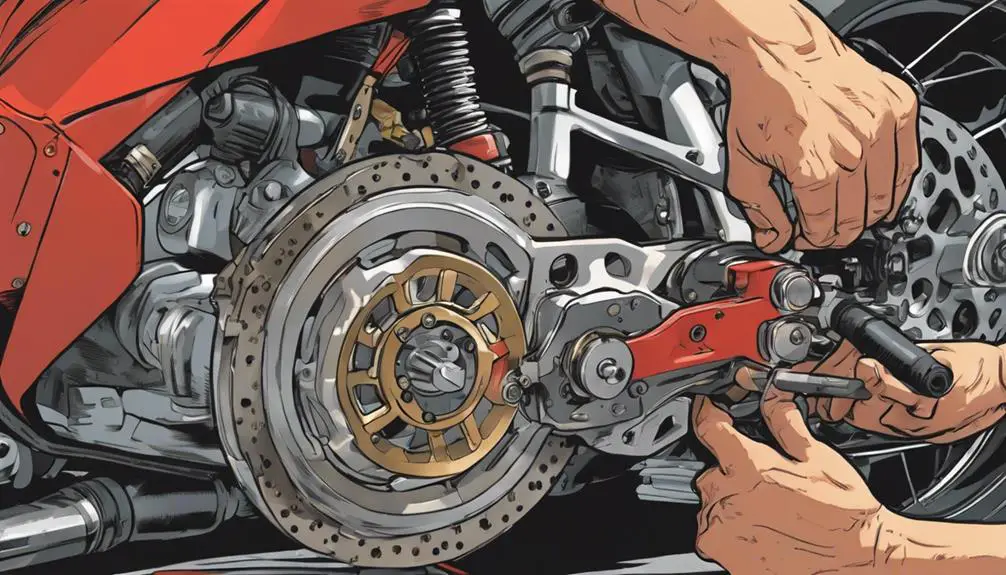
Inspect the brake system before every ride to guarantee peak performance and safety on your Ducati motorcycle. This isn't just a routine chore; it's a vital step toward experiencing the thrill of freedom on the open road.
Start by checking the brake fluid level. If it's low, top it off with the recommended fluid to confirm ideal braking power.
Next, examine the brake pads. Look for signs of wear or unevenness. If they're too thin, replace them immediately. Your safety is paramount, and worn pads can drastically reduce your stopping ability.
Don't forget to inspect the brake lines for any signs of cracks or leaks. A compromised line can lead to brake failure, taking away your freedom to ride with confidence.
Lastly, test the brake lever and pedal for firmness. If they feel spongy, air might've entered the system, and you'll need to bleed the brakes.
Chain Maintenance
Maintaining your Ducati's chain is essential for ideal performance and safety.
You'll want to inspect the chain tension regularly, clean and lubricate it consistently, and check for any signs of wear.
Inspect Chain Tension Regularly
Regularly checking your chain tension is vital for ideal performance and safety on your Ducati motorcycle. A well-adjusted chain allows for smooth power delivery, enhancing your ride's exhilarating feel. If the tension's off, you might experience poor handling or even damage to your bike.
To inspect it, start by placing your motorcycle on a stand. This lets the rear wheel spin freely, making it easier to measure the chain's slack. Grab the chain at its midpoint and pull it upwards; you should have about 1-2 inches of play, depending on your model. If it feels too tight or too loose, it's time to adjust.
Keep in mind that environmental factors, like riding style and terrain, can affect chain tension. If you're frequently hitting the winding roads or blasting down the highway, you might need to check more often.
Trust your instincts; if something feels off, don't hesitate to investigate further. Riding is all about freedom, and keeping your chain in check guarantees you can enjoy the open road without worry.
Embrace the ride, and let your Ducati roar!
Clean and Lubricate Consistently
Keeping your chain clean and lubricated is just as important as checking its tension for ideal performance and longevity of your Ducati motorcycle. A well-maintained chain not only enhances your ride but also empowers you to release your machine's full potential.
Start by cleaning your chain regularly—aim for every 300-600 miles, or more often if you ride in harsh conditions. Use a quality chain cleaner and a soft brush to remove dirt and grime that can wear down the links.
Once your chain is clean, it's time to lubricate. Apply a suitable chain lubricant, ensuring you cover every link. This step reduces friction and wear, making your rides smoother and more exhilarating.
Don't forget to wipe off excess lubricant to avoid attracting dirt, which can lead to premature wear.
Check for Wear Signs
After every few rides, take a moment to inspect your chain for signs of wear, as this can greatly impact your motorcycle's performance and safety.
Look closely for any stiff links, rust, or excessive play. If you notice any of these issues, it's time to act. A worn chain can lead to poor handling and even accidents, so don't underestimate this crucial component.
Check the chain's tension as well; it should neither be too tight nor too loose. Ideally, you want it to have about an inch of play. If it's off, adjust it immediately.
Also, inspect the sprockets for wear. Sharp teeth or uneven wear can signal that your chain is on its last legs.
Battery Care
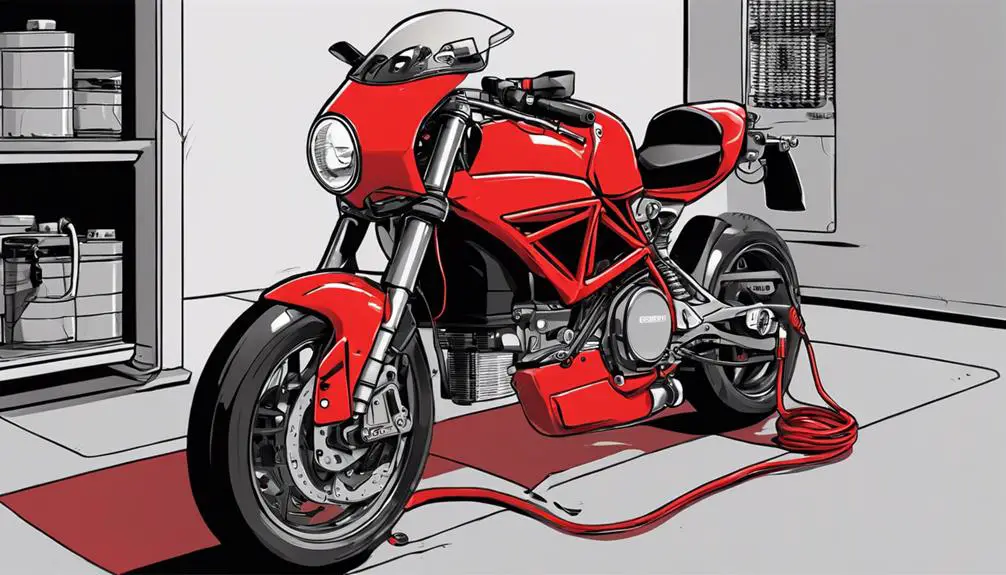
Your Ducati's battery deserves attentive care to guarantee reliable performance and longevity.
Begin by checking the battery terminals regularly; make sure they're clean and tight. Corrosion can sneak up on you, so wipe any buildup with a mixture of baking soda and water. This simple step can enhance connection and prevent electrical issues.
Next, monitor the battery's charge level. If your bike's been sitting idle for a while, consider using a smart charger to maintain its health. It's like giving your battery a little hug, making certain it's always ready to roar back to life when you are.
Keep an eye on the battery's age, too. Most batteries last about three to five years, depending on usage and conditions. If you notice sluggish starts or dim lights, it might be time for a replacement.
Lastly, if you plan on storing your Ducati, disconnect the battery and store it in a cool, dry place. This protects it from extreme temperatures and prolongs its lifespan.
Coolant Level Monitoring
Regularly checking the coolant level is crucial for maintaining your Ducati's engine temperature and overall performance. A well-cooled engine runs smoothly and responds better to your commands, empowering your ride.
To begin, locate the coolant reservoir, usually situated near the radiator. It's typically marked with minimum and maximum indicators, making it easy to see where you stand. Make it a habit to inspect the level before every ride. If the coolant is below the minimum line, you'll need to add more. Use the manufacturer-recommended coolant for best results. When adding coolant, verify the engine's cool to prevent burns from hot fluid.
Don't forget to check for leaks around hoses and connections. Any signs of leakage can lead to overheating, robbing you of the freedom of the open road. Keep an eye out for any changes in color or consistency of the coolant, as this could be a sign of contamination.
Air Filter Replacement
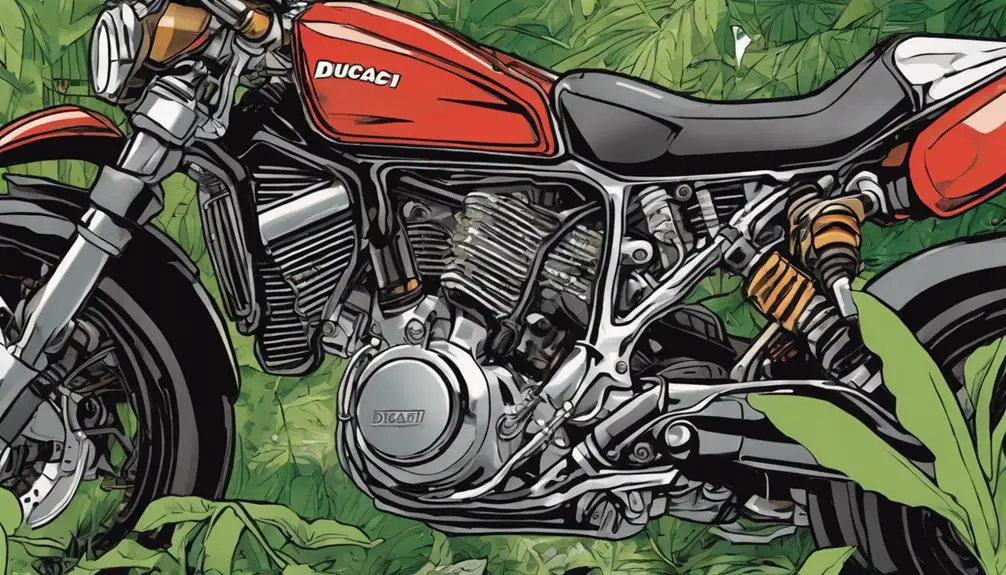
Maintaining ideal airflow is just as important as monitoring your coolant level, and replacing your air filter regularly guarantees your Ducati's engine breathes freely and performs at its best. A clean air filter enhances performance, boosts fuel efficiency, and helps you experience that exhilarating ride you crave.
To replace your air filter, start by locating the filter compartment, usually near the bike's airbox. You'll need a screwdriver to remove any screws or fasteners. Once you're in, take out the old filter and inspect it. If it's clogged or dirty, toss it aside.
Before inserting the new filter, clean the compartment to eliminate any debris. Slide the fresh filter into place, ensuring it fits snugly. When everything's secure, reassemble the compartment and give it a final check.
Make it a habit to inspect your air filter every 6,000 miles or so, or whenever you ride in dusty conditions. This simple act not only protects your engine but also enhances your freedom on the road. With a clean air filter, you'll release the full potential of your Ducati and enjoy every twist and turn of your journey. Ride on!
Spark Plug Inspection
Every few thousand miles, it's important to inspect the spark plugs to guarantee your Ducati's engine runs smoothly and efficiently. Neglecting this essential task can lead to poor performance, reduced fuel efficiency, and even engine damage. Start by locating the spark plugs; they're usually found near the top of the engine.
Once you've found them, remove each plug using a spark plug socket. Check for any signs of wear, such as carbon buildup, oil deposits, or corrosion. A clean, well-functioning spark plug should have a light tan color and minimal residue. If you notice excessive buildup or damage, it's time to replace the spark plug.
While you're at it, check the gap between the electrodes using a feeler gauge. This gap is important for optimal ignition. If it's out of spec, adjust it accordingly.
Reinstall the plugs carefully, ensuring they're tightened to the manufacturer's specifications. Properly maintained spark plugs can unlock the full potential of your Ducati, providing that exhilarating ride you crave.
Electrical System Review
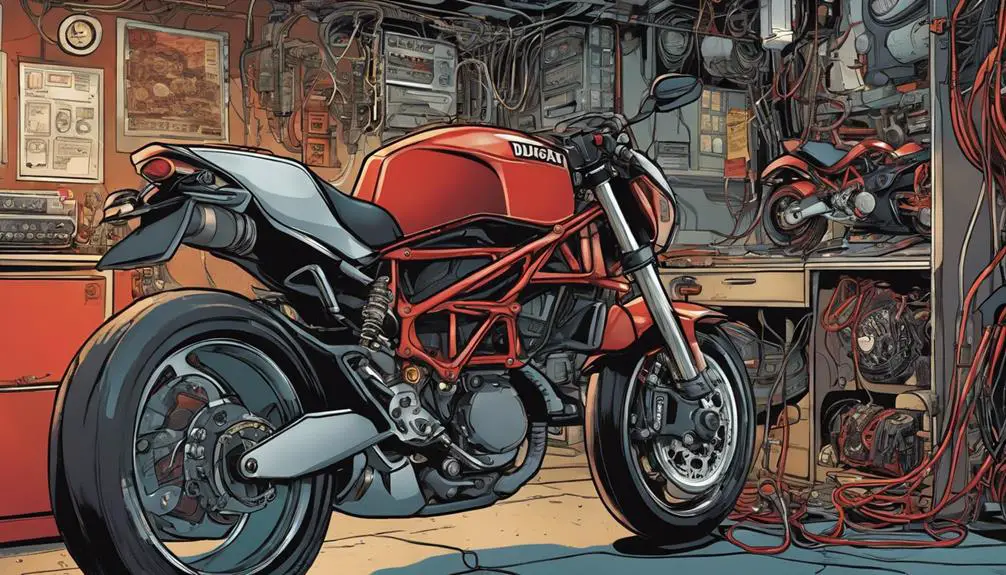
Inspecting your Ducati's electrical system is just as important as checking the spark plugs, as a well-functioning electrical system guarantees reliable starting and peak performance.
Neglecting this aspect can lead to frustrating rides and unexpected breakdowns. So, take a moment to connect with your ride and verify everything's in top shape.
Here are a few key areas to focus on during your electrical system review:
- Battery Health: Check for corrosion on terminals and verify a secure connection.
- Wiring Inspection: Look for frayed or damaged wires that could cause shorts.
- Fuses: Inspect all fuses and replace any that are blown to keep your system protected.
- Lights and Signals: Test all lights and indicators for proper functioning to enhance visibility and safety.
Frequently Asked Questions
How Often Should I Wash My Ducati Motorcycle?
You should wash your Ducati motorcycle regularly, ideally every two to four weeks, depending on your riding conditions.
If you ride in wet or muddy environments, you might want to wash it more often to prevent dirt buildup and corrosion.
Always use a gentle cleaner and soft cloths to keep your bike looking sharp.
What Type of Fuel Is Best for My Ducati?
When it comes to fueling your Ducati, you wanna go for premium unleaded gasoline with an octane rating of at least 95.
This type of fuel helps your bike perform at its finest, ensuring smooth acceleration and peak efficiency.
Using lower octane fuel can lead to knocking and reduced power.
Can I Modify My Ducati Without Voiding the Warranty?
You can modify your Ducati, but it's essential to tread carefully.
Many manufacturers allow certain upgrades without voiding the warranty, like exhaust systems or air filters, but others might not. Always check your warranty terms first.
If you're uncertain, consult your dealer or a Ducati expert before making changes.
This way, you can enjoy your ride and keep that warranty intact, letting you embrace your freedom on the road without worry.
Where Can I Find OEM Parts for My Ducati?
When you're looking for OEM parts for your Ducati, start with the official Ducati website. They offer an extensive catalog of parts tailored for your model.
You can also check authorized dealerships and reputable motorcycle shops for genuine parts.
Online marketplaces like eBay or specialized Ducati forums often have listings, but make sure to verify authenticity.
You'll want to keep your ride in top shape without any compromises on quality!
How Do I Store My Ducati During Winter?
When you're storing your Ducati during winter, make sure you clean it thoroughly to prevent corrosion.
You should fill up the tank and add stabilizer to keep the fuel fresh.
Disconnect the battery to avoid drainage, and consider using a battery maintainer.
Cover your bike with a breathable cover to protect it from dust and moisture.
Conclusion
To summarize, keeping your Ducati in top shape is like tuning a fine violin—every detail matters for a flawless performance.
By following these maintenance tips, you'll guarantee your ride is smooth, safe, and ready for the open road.
Don't let neglect turn your motorcycle into a relic; regularly check the oil, tires, and brakes to keep the thrill alive.
So gear up and hit the road—the adventure awaits, and your Ducati deserves the best!